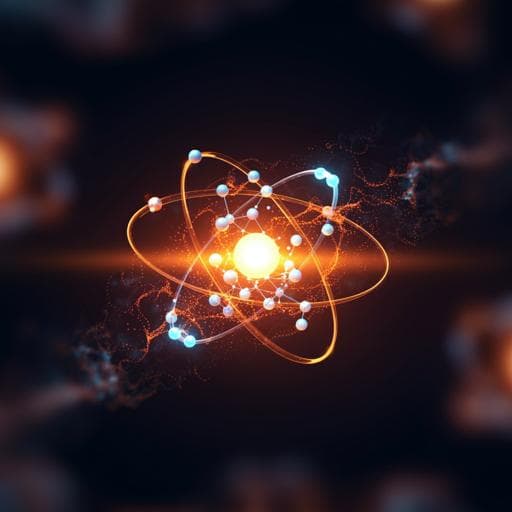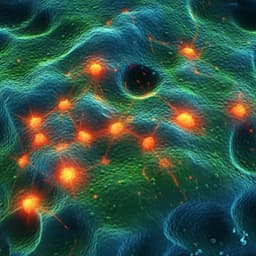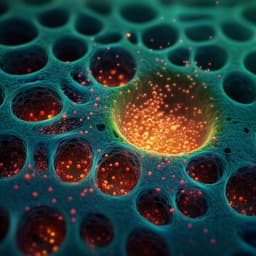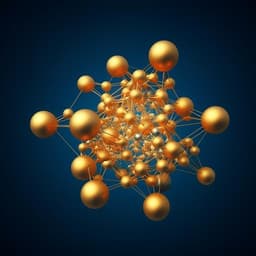
Chemistry
Importance of broken geometric symmetry of single-atom Pt sites for efficient electrocatalysis
J. Cho, T. Lim, et al.
This groundbreaking research by Junsic Cho and colleagues uncovers the crucial role of low-coordinated PtII species in enhancing the chlorine evolution reaction through platinum single-atom catalysts. Advanced spectroscopic studies reveal unexpected PtII moieties that could redefine electrocatalytic performance with new insights for carbon-based SACs.
~3 min • Beginner • English
Introduction
Single-atom catalysts (SACs) promise high activity and low cost, but growing evidence shows substantial heterogeneity of active sites, complicating identification of the genuine catalytic site and intrinsic activity. The study targets archetypal Pt SACs, typically PtII (d8) stabilized in square-planar (D4h) coordination such as Pt–N4/S4 on carbon supports. Ligand-field considerations predict strong splitting that weakens axial coordination, suggesting symmetric Pt–N4 sites are catalytically suboptimal, whereas broken or unsaturated geometries may enhance activity. Prior discrepancies between experimentally high performance of carbon-supported Pt SACs and theory motivate the central question: which Pt site geometry is truly active under electrocatalytic conditions, and does broken geometric symmetry (low coordination) govern activity and stability, specifically for the chlorine evolution reaction (CER)?
Literature Review
Prior theoretical and experimental work has proposed asymmetric Pt coordination environments (e.g., Pt–NC4−x) and dynamic in situ modifications of symmetric geometries via ligand exchange with electrolyte species or oxidation state changes. Standard EXAFS often assigns Pt–N4/S4 porphyrin-like geometries but cannot easily resolve coexisting moieties. Theory suggests unsaturated sites with optimized axial coordination outperform symmetric D4h sites. Previous reports indicated poor to moderate performance for symmetric Pt–N4 and posited active roles for low-coordinated species, yet definitive evidence and assignment under operating electrochemical conditions remained unresolved due to site heterogeneity and limited structural sensitivity of conventional probes.
Methodology
- Catalyst synthesis: Carbon nanotubes (CNTs) were heat-treated and acid-washed. Pt single-atom catalysts were synthesized by solid-state mixing of acid-treated CNTs with Pt(II) tetraphenylporphyrin (PtTPP) followed by pyrolysis at 700 °C under N2. Pt loadings prepared: 3, 1, and 0.15 wt.% (denoted Pt1(3)/CNT, Pt1(1)/CNT, Pt1(0.15)/CNT). N-doped CNT control was prepared using metal-free TPP. Post-treatments generated O- and Cl-functionalized variants (O-Pt1(3)/CNT via O3; Cl-Pt1(3)/CNT via H2O2 then SO2Cl2) without detectable Pt loss.
- Physical characterization: HAADF-STEM, XRD, XPS, ex situ Pt L3-edge XAS (XANES/EXAFS), ICP-OES for Pt content. EXAFS fitting used standard procedures and Pt foil calibration.
- Electrochemical testing: CER evaluated in 0.1 M HClO4 + 1 M NaCl using RDE; onset potential and polarization curves acquired with 85% iR compensation. Selectivity assessed by DEMS (monitoring m/z 35, 36, 51, 32) and RRDE. CO poisoning tests probed site nature. Durability: 500 CV cycles between 1.0–1.6 VRHE.
- Online dissolution: EFC/ICP-MS quantified real-time Pt dissolution in 0.1 M HClO4 + 1 M NH4Cl during the same CV protocol; Pt residue estimated by subtracting dissolved Pt from initial content.
- In situ spectroscopy: In situ Pt L3-edge XANES/EXAFS in flow cell under 0.1 M HClO4 + 1 M NaCl at OCP and 1.45 VRHE to detect intermediate adsorption and coordination changes (Pt–Cl, Pt–N/O CNs).
- Computational modeling: DFT (VASP) constructed models for square-planar Pt–N4, trigonal-planar Pt–N3, and T-shaped Pt–N3V on a carbon support. Pourbaix analysis identified stable surface states under CER conditions. Free-energy diagrams for CER via *Cl− and *OCl pathways and OER via *OH/*O/*OOH were computed. Activity descriptor Gmax(U) quantified the largest free-energy span at 1.36 VSHE. A stability descriptor Udiss (equilibrium potential for oxidative demetallation to PtO2) assessed site robustness under CER conditions.
Key Findings
- High CER activity and selectivity: Pt1(3)/CNT shows onset at ~1.36 VRHE and reaches ~53 mA cm−2 at 1.45 VRHE in 0.1 M HClO4 + 1 M NaCl. DEMS detects dominant Cl-related signals (m/z 35, 36, 51) with negligible O2 within CER-relevant potentials; RRDE confirms ~100% CER selectivity.
- Active site nature: CO poisoning significantly suppresses CER, implicating atomically isolated PtII sites.
- Durability vs dissolution (3 wt.% case): After 500 CVs (1.0–1.6 VRHE), activity drops 61% (53 to 21 mA cm−2), while Pt loss is only 22% by EFC/ICP-MS, indicating that simple loss of total Pt sites does not account for deactivation.
- Surface functional groups: Aging introduces O (C=O/C–O) and organochlorine functionalities (XPS O 1s at ~532.3 eV; Cl 2p at ~200.4 eV). Model catalysts enriched with O or Cl groups show CER curves nearly identical to pristine, suggesting these functionalities do not drive TOF degradation.
- Loading-dependent TOF and coordination: Despite lower total Pt, Pt1(1)/CNT and Pt1(0.15)/CNT deliver 49 and 39 mA cm−2 at 1.45 VRHE, corresponding to ~3× and ~15× higher TOF than Pt1(3)/CNT. EXAFS reveals decreasing Pt–N CN with loading: ~4.0 (3 wt.%), 3.4 (1 wt.%), 3.0 (0.15 wt.%), evidencing stabilization of low-coordinated PtII sites (Pt–N3 or Pt–N3V) alongside Pt–N4.
- In situ XAS: At 1.45 VRHE, WL intensity increases with decreasing Pt loading (higher fraction of low-coordinated sites) and Pt–Cl scattering (~2.3 Å) grows as Pt content decreases. For Pt1(0.15)/CNT, CNPt–N/O increases from ~3 ex situ to ~4 in situ, consistent with an additional Pt–O cap under operating conditions; CNPt–N/O:CNPt–Cl ~ 4:1 supports prevalent Pt–N3(V) active sites.
- Activity tied to Pt–N3(V): Estimations suggest Pt–N3(V) content governs CER activity; extrapolations yield Pt–N3(V)/Pt–N4 contents of ~0.19/0.81 wt.% (1 wt.%) and ~0.20/2.8 wt.% (3 wt.%). The more active site is rarer at higher loadings.
- Deactivation traced to loss of Pt–N3(V): For Pt1(0.15)/CNT, after 500 CVs activity drops 84% and Pt loss is 70%, with similar time profiles; across loadings, higher Pt–N3(V) fraction correlates with greater Pt loss.
- DFT mechanisms and activity: Under CER conditions, Pt–N4 favors an axially unoccupied site with CER via the *Cl− path (Gmax ≈ 0.32 eV), while Pt–N3 and Pt–N3V are capped by O and proceed via the *OCl path with lower barriers (Gmax ≈ 0.21 and 0.05 eV, respectively). The model predicts ~100% CER selectivity for all sites, consistent with experiments.
- Stability descriptor: Udiss (Pt demetallation to PtO2) indicates stability order Pt–N4 (2.98 VSHE) > Pt–N3V (1.99 VSHE) > Pt–N3 (0.78 VSHE). Pt–N3 is unstable under CER (U > 1.36 VSHE), whereas T-shaped Pt–N3V is identified as the likely active yet less stable site responsible for high CER activity and selectivity.
- Resolution of activity–dissolution discrepancy: Coexistence of an active but labile minority (Pt–N3V) with a less active majority (Pt–N4) explains large activity losses with modest total Pt dissolution at higher loadings.
Discussion
The study demonstrates that breaking the ideal square-planar symmetry of PtII centers to form low-coordinated Pt–N3(V) moieties unlocks superior CER kinetics while maintaining high selectivity. This resolves long-standing discrepancies between theoretical predictions based on symmetric Pt–N4 sites and experimental performance of Pt SACs by revealing site heterogeneity and identifying the true active site. In situ spectroscopy corroborates that under operating potentials, Pt–N3(V) binds oxygen (forming Pt–O), favoring an *OCl pathway with significantly reduced free-energy span relative to Pt–N4. However, the enhanced activity comes with reduced stability; deactivation is governed primarily by loss of Pt–N3(V) rather than changes in TOF due to support functionalization or total Pt content. Consequently, optimizing catalyst design entails maximizing the density of Pt–N3V sites while mitigating their demetallation under CER conditions, and recognizing that apparent activity scales with the population of these unsaturated sites rather than total Pt or Pt–N4 abundance.
Conclusion
This work identifies low-coordinated PtII single-atom sites with broken geometric symmetry—specifically T-shaped Pt–N3V—as the genuine, highly active and selective centers for the chlorine evolution reaction on carbon supports. Comprehensive experiments (electrochemistry, DEMS/RRDE selectivity, online EFC/ICP-MS dissolution, ex/in situ XAS) combined with DFT mechanistic and stability analyses establish that Pt–N3V outperforms Pt–N4 via an *OCl pathway, but is less stable under anodic conditions. The findings reconcile inconsistencies between theory and experiment by accounting for site heterogeneity and provide design principles for SACs: increase the fraction of low-coordinated sites while balancing activity–stability trade-offs. Future directions include synthetic strategies to preferentially form and stabilize three-coordinate Pt sites, tuning ligand-field strength and axial coordination, engineering the catalyst–electrolyte interface and operating protocols to prolong site longevity, and unraveling the fundamental origins of Pt–N3(V) stabilization on carbon. The concepts likely extend to other dn single-atom metals beyond PtII.
Limitations
- Limited attainable fraction of active Pt–N3(V) sites: experimentally appears to converge to ~0.2 wt.% irrespective of total Pt loading.
- Intrinsic instability under CER: DFT indicates trigonal-planar Pt–N3 is unstable (Udiss ~0.78 VSHE) and even Pt–N3V is less stable than Pt–N4, leading to deactivation via demetallation.
- Structural resolution constraints: EXAFS, though powerful, cannot fully disentangle coexisting Pt moieties; some assignments rely on indirect indicators and in situ trends.
- Estimation assumptions: Quantification of Pt–N3(V) content by linear extrapolation assumes identical TOFs of Pt–N3(V) across samples and may introduce uncertainty.
- Durability testing employed accelerated CV protocols that may not fully represent steady-state industrial electrolysis conditions.
- Study focuses on CER in acidic chloride media; generalization to other reactions or electrolytes requires further validation.
Related Publications
Explore these studies to deepen your understanding of the subject.







